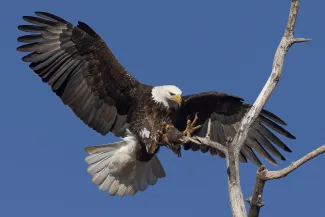Oklahoma’s bald eagle numbers peak between November and February, making winter the prime season for eagle watching. Stack the odds of seeing our Nation’s symbol in your favor with these tips.

Go Where the Eagles Are
Bald eagles are primarily fish eaters and can be found around many of Oklahoma’s rivers and lakes. Popular viewing spots include Kaw Lake, the Grand Lake O’ the Cherokees and Lake Texoma but bald eagles can be spotted across the state as long as food is nearby and available.
More than 300 pairs of bald eagles stay here year-round, but a majority of our eagles split time between Oklahoma and more northern states. When the fishing holes freeze over in those northern states, the migratory birds return south to enjoy Oklahoma’s (and other southern states) more mild winters and open waters.
Eagle sightings are frequently logged on free nature sharing platforms like eBird and iNaturalist. Consider creating an account to view observations from across the state.
More Places to view eagles
- Sequoyah National Wildlife Refuge
- Keystone Lake and Keystone State Park
- Lake Thunderbird
- Chickasaw National Recreation Area
- Salt Plains National Wildlife Refuge
- Arcadia Lake
- Quartz Mountain State Park
- Black Mesa State Park and Nature Preserve
- Grand Lake State Park
- Illinois River
- Joseph H. Williams Tallgrass Prairie Preserve
- Kaw Lake
Be Prepared to Bundle Up and Wait
Depending on the weather, winter eagle watching in Oklahoma could be enjoyed in a long-sleeved shirt and jeans, or may require your heaviest winter gear. Wearing layers and keeping a scarf and gloves handy can help you adjust to the varying temperature and wind conditions.
Depending on the location, eagle watching could be enjoyed from a warm car, or require a walk along the shoreline or trail. Be sure to find a safe place to pull off the road if eagle watching from a vehicle.
Depending on the birds, your eagle watching trip could be successful in a matter of minutes or hours or may require a raincheck for another day! Time your trips for early morning or late afternoon to increase your chances of seeing these fishing raptors.
Best time to view and what to bring
- Sightings increase as early as November and peak in January and February.
- Look near lakes and rivers as eagles are primarily fish eaters and typically nest in forested areas near large bodies of water.
- Wear warm, neutral-colored clothing.
- Bring binoculars, a camera, and a field guide.
Scan the Tree Lines
Eagles spend a majority of their time perched high in a tree. When you first arrive at your eagle-watching destination, scan the surrounding trees for the contrasting brown body and white head and tail of adult eagles. Eagles under the age of four years lack the characteristic white head and tail and may be more difficult to spot. Once you’ve scanned the area for adult eagles, inspect the same area for the large, dark-bodied juveniles.
Pack a pair of binoculars or a spotting scope to turn the odds of spotting an eagle in your favor.
Additional History and Information
- Bald eagle populations declined in the mid-1900s and reached a low of 417 pairs in 1963.
- Populations began to increase after banning the pesticide DDT and through the federal listing of the bald eagle as an endangered and threatened species in the 1970s.
- The bald eagle was removed from the federal list of endangered and threatened species in 2007.
- The estimated breeding population is now estimated at over 316,000.
Literature Cited
Buehler, D. A. 2000. Bald Eagle (Haliaeetus leucocephalus). In The Birds of North America, No. 506 (A. Poole and F. Gill, Editors). The Birds of North America, Inc., Philadelphia, PA, USA.
Partners in Flight. 2020. Avian Conservation Assessment Database, version 2020.
Smith N. R., Hess T. J., and Afton A. D. 2016. History and nesting population of bald eagles in Louisiana. Southeastern Naturalist 15(1), 12-25.